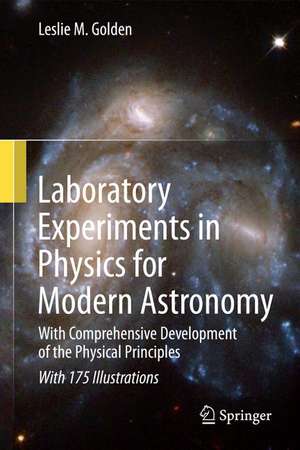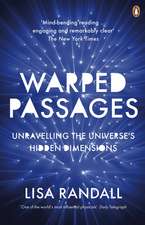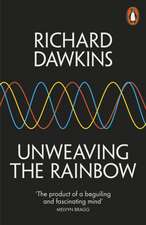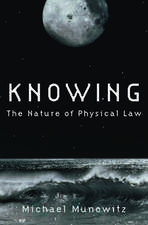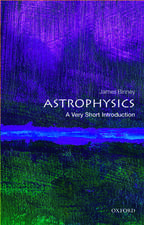Laboratory Experiments in Physics for Modern Astronomy: With Comprehensive Development of the Physical Principles
Autor Leslie M. Goldenen Limba Engleză Hardback – 15 noi 2012
| Toate formatele și edițiile | Preț | Express |
|---|---|---|
| Paperback (1) | 485.93 lei 6-8 săpt. | |
| Springer – 13 dec 2014 | 485.93 lei 6-8 săpt. | |
| Hardback (1) | 520.20 lei 6-8 săpt. | |
| Springer – 15 noi 2012 | 520.20 lei 6-8 săpt. |
Preț: 520.20 lei
Preț vechi: 612.00 lei
-15% Nou
Puncte Express: 780
Preț estimativ în valută:
99.55€ • 103.80$ • 82.74£
99.55€ • 103.80$ • 82.74£
Carte tipărită la comandă
Livrare economică 20 martie-03 aprilie
Preluare comenzi: 021 569.72.76
Specificații
ISBN-13: 9781461433101
ISBN-10: 146143310X
Pagini: 376
Ilustrații: XXX, 570 p.
Dimensiuni: 155 x 235 x 30 mm
Greutate: 1 kg
Ediția:2013
Editura: Springer
Colecția Springer
Locul publicării:New York, NY, United States
ISBN-10: 146143310X
Pagini: 376
Ilustrații: XXX, 570 p.
Dimensiuni: 155 x 235 x 30 mm
Greutate: 1 kg
Ediția:2013
Editura: Springer
Colecția Springer
Locul publicării:New York, NY, United States
Public țintă
Upper undergraduateCuprins
PART I TOOLS OF THE ASTRONOMER.- Introduction.- A Review of Mathematical Concepts and Tools .- A Review of Graphing Techniques .- The Optics of Telescopes, I. Image Size and Brightness.- The Optics of Telescopes, II. Magnification and Chromatic Aberration.- PART II. THE SOLAR SYSTEM.- Introduction.- Earth, The Seasons and Local Latitude.- The Surface Roughness of the Moon, Reflection and Scattering from a Planetary Surface I. Surface Materials.- The Surface Roughness of the Moon, Reflection and Scattering from a Planetary Surface II. Beads and Surface Coverage.- The Formation of Impact Craters.- Determination of the Rotation Rate of Planets and Asteroids by Radar, I. Observations of Mercury .- Determination of the Rotation Rate of Planets and Asteroids by Radar, II. Observations of Simulated Planets.- The Orbit of Venus.- Kepler's Laws of Planetary Motion .- The Galilean Satellites of Jupiter .- Thermal Radiation from a Planetary Subsurface, I. Calibration and Initial Measurements .- Thermal Radiation from a Planetary Subsurface, II. Soil Sample Measurements.- The Microwave Phase Effect of the Moon .- PART III. MEASURING THE STARS AND BEYOND.- Introduction.- Blackbody Radiation .- The Surface Temperature and Energy Output of the Sun.- The Theory of Atomic Spectra: The Balmer Lines .- Discovering the Nature of Objects in Space: Kirchhoff's Laws of Radiation.- Appendices.- Index
Recenzii
From the reviews:
“This textbook is different from many others in the field. … It was written to help students of astronomy to understand physics concepts in practical lab work. … I fully recommend this book. … The book’s content is suitable for many undergraduate physics courses where the content has reference to astronomy. As such, I recommend the book as very good supplementary material.” (Michael Vollmer, Physics Education, July, 2013)
"...I fully recommend this book. I learned or rediscovered quite a bit of interesting astronomy and I particularly liked the short descriptions of the physics background for the chosen activities." -Michael Volmer, Physics Education July 2013
“This textbook is different from many others in the field. … It was written to help students of astronomy to understand physics concepts in practical lab work. … I fully recommend this book. … The book’s content is suitable for many undergraduate physics courses where the content has reference to astronomy. As such, I recommend the book as very good supplementary material.” (Michael Vollmer, Physics Education, July, 2013)
"...I fully recommend this book. I learned or rediscovered quite a bit of interesting astronomy and I particularly liked the short descriptions of the physics background for the chosen activities." -Michael Volmer, Physics Education July 2013
Notă biografică
Leslie M. Golden obtained his undergraduate education at Cornell University in engineering physics, with distinction, while working summers performing planetary exploration simulation studies at the AstroSciences Center of the Illinois Institute of Technology. At Cornell he worked with Bruce Hapke on characteristics of the lunar surface and studied under his early mentor, Frank Drake. His Ph.D was earned at the University of California, Berkeley, where he performed research in a variety of areas, working with Leland Cunningham on software for the determination of the orbits of comets, Carl Heiles on the definitive 21-cm map of the galaxy, Harold Weaver on selection effects in studying the evolution of quasars, and W.H. McCrea on isotropy of radio source counts with position over the sky. His dissertation, a microwave interferometric study of the subsurface of Mercury, was performed under William J. Welch with the prototype Hat Creek interferometer. It was cited as one of only two dissertations for excellence in the year of completion by the Berkeley chapter of Phi Beta Kappa. The models he devised form the basis for thermophysical models of planetary surfaces still currently employed.
Dr. Golden obtained a National Research Council grant and continued interferometric studies of Mercury at the Jet Propulsion Laboratory and as a consultant at the Aerospace Corporation before receiving his academic appointment at the University of Illinois at Chicago.
Writing and public speaking allow Dr. Golden to share his enthusiasm. In addition to numerous technical articles, he was the award winning editor-in-chief of the Cornell Engineer magazine, and won the senior division of the Nicolaus Copernicus 500th Anniversary science-writing competition, the Eric Hoffer-Lili Fabilli Essay Award, and an award in the Griffith Observatory Science Writing Contest.
In demand as an authoritative and entertaining public speaker and lecturer, Dr. Golden, among many engagements, was selected by Royal Cruise Lines to be their on-board lecturer on the high seas during the 1986 apparition of Halley’s Comet, addressed the Adler Planetarium as the keynote speaker during the opening of their new wing, provided a lecture series on extraterrestrial life to the Field Museum of Natural History, and has been the only University of Illinois professor to be selected as a visiting faculty member on Semester at Sea through the University of Pittsburgh. He speaks widely to library, school, youth, and adult groups on various topics in astronomy.
Dr. Golden is one of a handful of individuals who is a member of both Tau Beta Pi, the engineering honorary society, and Phi Beta Kappa, the arts and sciences honorary society. He was also elected to Pi Delta Epsilon, the honorary journalism society.
Dr. Golden obtained a National Research Council grant and continued interferometric studies of Mercury at the Jet Propulsion Laboratory and as a consultant at the Aerospace Corporation before receiving his academic appointment at the University of Illinois at Chicago.
Writing and public speaking allow Dr. Golden to share his enthusiasm. In addition to numerous technical articles, he was the award winning editor-in-chief of the Cornell Engineer magazine, and won the senior division of the Nicolaus Copernicus 500th Anniversary science-writing competition, the Eric Hoffer-Lili Fabilli Essay Award, and an award in the Griffith Observatory Science Writing Contest.
In demand as an authoritative and entertaining public speaker and lecturer, Dr. Golden, among many engagements, was selected by Royal Cruise Lines to be their on-board lecturer on the high seas during the 1986 apparition of Halley’s Comet, addressed the Adler Planetarium as the keynote speaker during the opening of their new wing, provided a lecture series on extraterrestrial life to the Field Museum of Natural History, and has been the only University of Illinois professor to be selected as a visiting faculty member on Semester at Sea through the University of Pittsburgh. He speaks widely to library, school, youth, and adult groups on various topics in astronomy.
Dr. Golden is one of a handful of individuals who is a member of both Tau Beta Pi, the engineering honorary society, and Phi Beta Kappa, the arts and sciences honorary society. He was also elected to Pi Delta Epsilon, the honorary journalism society.
Textul de pe ultima copertă
This book presents experiments which will teach physics relevant to astronomy. The astronomer, as instructor, frequently faces this need when his college or university has no astronomy department and any astronomy course is taught in the physics department. The physicist, as instructor, will find this intellectually appealing when faced with teaching an introductory astronomy course. From these experiments, the student will acquire important analytical tools, learn physics appropriate to astronomy, and experience instrument calibration and the direct gathering and analysis of data. Experiments that can be performed in one laboratory session as well as semester-long observation projects are included.
This textbook is aimed at undergraduate astronomy students.
This textbook is aimed at undergraduate astronomy students.
Caracteristici
Teaches physics relevant to astronomy, providing clear and often humorous exercises Presents physics experiments using radio, radar and optical astronomy techniques applied in the modern exploration of the solar system Includes supplementary material: sn.pub/extras
